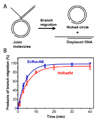Rad54, the motor of homologous recombination
- PMID: 20089461
- PMCID: PMC2827677
- DOI: 10.1016/j.dnarep.2009.12.006
Rad54, the motor of homologous recombination
Abstract
Homologous recombination (HR) performs crucial functions including DNA repair, segregation of homologous chromosomes, propagation of genetic diversity, and maintenance of telomeres. HR is responsible for the repair of DNA double-strand breaks and DNA interstrand cross-links. The process of HR is initiated at the site of DNA breaks and gaps and involves a search for homologous sequences promoted by Rad51 and auxiliary proteins followed by the subsequent invasion of broken DNA ends into the homologous duplex DNA that then serves as a template for repair. The invasion produces a cross-stranded structure, known as the Holliday junction. Here, we describe the properties of Rad54, an important and versatile HR protein that is evolutionarily conserved in eukaryotes. Rad54 is a motor protein that translocates along dsDNA and performs several important functions in HR. The current review focuses on the recently identified Rad54 activities which contribute to the late phase of HR, especially the branch migration of Holliday junctions.
(c) 2009 Elsevier B.V. All rights reserved.
Figures










Similar articles
-
Rad54 protein promotes branch migration of Holliday junctions.Nature. 2006 Aug 3;442(7102):590-3. doi: 10.1038/nature04889. Epub 2006 Jul 2. Nature. 2006. PMID: 16862129
-
Functions of the Snf2/Swi2 family Rad54 motor protein in homologous recombination.Biochim Biophys Acta. 2011 Sep;1809(9):509-23. doi: 10.1016/j.bbagrm.2011.06.006. Epub 2011 Jun 16. Biochim Biophys Acta. 2011. PMID: 21704205 Free PMC article. Review.
-
RAD54 is essential for RAD51-mediated repair of meiotic DSB in Arabidopsis.PLoS Genet. 2021 May 18;17(5):e1008919. doi: 10.1371/journal.pgen.1008919. eCollection 2021 May. PLoS Genet. 2021. PMID: 34003859 Free PMC article.
-
Synergistic Roles of Non-Homologous End Joining and Homologous Recombination in Repair of Ionizing Radiation-Induced DNA Double Strand Breaks in Mouse Embryonic Stem Cells.Cells. 2024 Aug 30;13(17):1462. doi: 10.3390/cells13171462. Cells. 2024. PMID: 39273031 Free PMC article.
-
Rad54: the Swiss Army knife of homologous recombination?Nucleic Acids Res. 2006;34(15):4115-25. doi: 10.1093/nar/gkl481. Epub 2006 Aug 25. Nucleic Acids Res. 2006. PMID: 16935872 Free PMC article. Review.
Cited by
-
Polarity and bypass of DNA heterology during branch migration of Holliday junctions by human RAD54, BLM, and RECQ1 proteins.J Biol Chem. 2012 Apr 6;287(15):11820-32. doi: 10.1074/jbc.M112.341347. Epub 2012 Feb 22. J Biol Chem. 2012. PMID: 22356911 Free PMC article.
-
New Facets of DNA Double Strand Break Repair: Radiation Dose as Key Determinant of HR versus c-NHEJ Engagement.Int J Mol Sci. 2023 Oct 6;24(19):14956. doi: 10.3390/ijms241914956. Int J Mol Sci. 2023. PMID: 37834403 Free PMC article. Review.
-
Premature senescence and cardiovascular disease following cancer treatments: mechanistic insights.Front Cardiovasc Med. 2023 Sep 14;10:1212174. doi: 10.3389/fcvm.2023.1212174. eCollection 2023. Front Cardiovasc Med. 2023. PMID: 37781317 Free PMC article. Review.
-
Physiology of the read-write genome.J Physiol. 2014 Jun 1;592(11):2319-41. doi: 10.1113/jphysiol.2014.271130. J Physiol. 2014. PMID: 24882816 Free PMC article. Review.
-
A fine-scale dissection of the DNA double-strand break repair machinery and its implications for breast cancer therapy.Nucleic Acids Res. 2014 Jun;42(10):6106-27. doi: 10.1093/nar/gku284. Epub 2014 May 3. Nucleic Acids Res. 2014. PMID: 24792170 Free PMC article. Review.
References
-
- Krogh BO, Symington LS. Recombination proteins in yeast. Annu Rev Genet. 2004;38:233–271. - PubMed
-
- San Filippo J, Sung P, Klein H. Mechanism of eukaryotic homologous recombination. Annu Rev Biochem. 2008;77:229–257. - PubMed
-
- Bishop DK. Multiple mechanisms of meiotic recombination. Cell. 2006;127:1095–1097. - PubMed
Publication types
MeSH terms
Substances
Grants and funding
LinkOut - more resources
Full Text Sources
Research Materials

